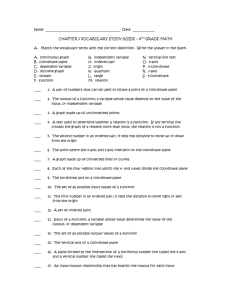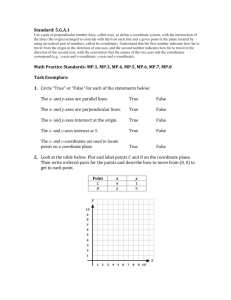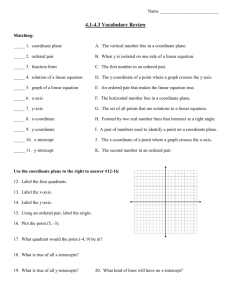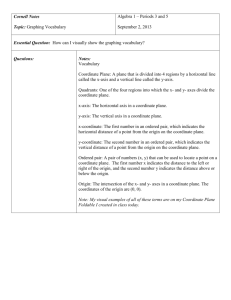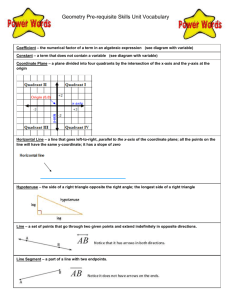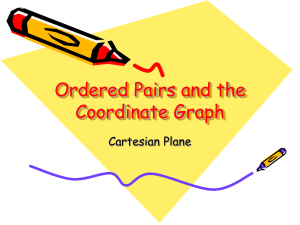Name Chapter 2 Vocabulary Complex fractions: A fraction a/b where
advertisement
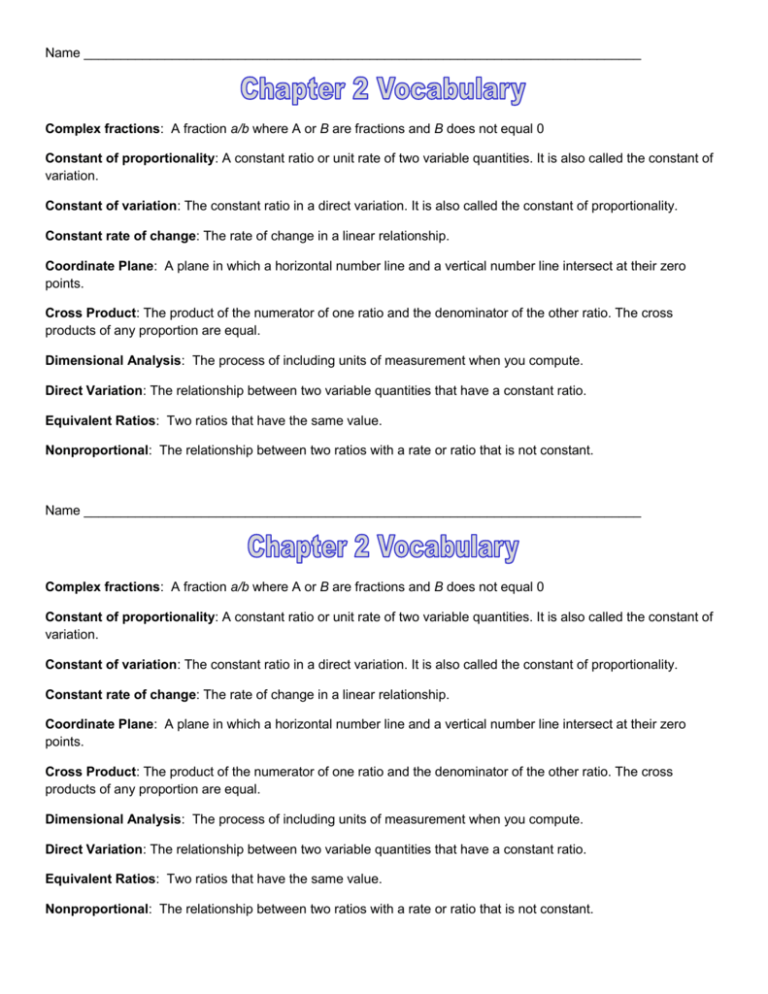
Name ____________________________________________________________________________ Complex fractions: A fraction a/b where A or B are fractions and B does not equal 0 Constant of proportionality: A constant ratio or unit rate of two variable quantities. It is also called the constant of variation. Constant of variation: The constant ratio in a direct variation. It is also called the constant of proportionality. Constant rate of change: The rate of change in a linear relationship. Coordinate Plane: A plane in which a horizontal number line and a vertical number line intersect at their zero points. Cross Product: The product of the numerator of one ratio and the denominator of the other ratio. The cross products of any proportion are equal. Dimensional Analysis: The process of including units of measurement when you compute. Direct Variation: The relationship between two variable quantities that have a constant ratio. Equivalent Ratios: Two ratios that have the same value. Nonproportional: The relationship between two ratios with a rate or ratio that is not constant. Name ____________________________________________________________________________ Complex fractions: A fraction a/b where A or B are fractions and B does not equal 0 Constant of proportionality: A constant ratio or unit rate of two variable quantities. It is also called the constant of variation. Constant of variation: The constant ratio in a direct variation. It is also called the constant of proportionality. Constant rate of change: The rate of change in a linear relationship. Coordinate Plane: A plane in which a horizontal number line and a vertical number line intersect at their zero points. Cross Product: The product of the numerator of one ratio and the denominator of the other ratio. The cross products of any proportion are equal. Dimensional Analysis: The process of including units of measurement when you compute. Direct Variation: The relationship between two variable quantities that have a constant ratio. Equivalent Ratios: Two ratios that have the same value. Nonproportional: The relationship between two ratios with a rate or ratio that is not constant. Ordered pairs: A pair of numbers used to locate a point in the coordinate plane. An ordered pair is written is the form (x-coordinate, y-coordinate) Origin: The point at which the x-axis and the y-axis intersect in a coordinate plane, The origin is at (0,0). Proportion: An equation stating that two ratios or rates are equivalent. Proportional: The relationship between two ratios with a constant rate or ratio. Quadrants: One of the four into which the two perpendicular number lines of the coordinate plane separate the plane. Rate: A ratio that compares two quantities with different kinds of units. Rate of change: A rate that describes how one quantity changes in relation to another. A rate of change is usually expressed as a unit rate. Unit rate: A rate that is simplified so that it has a denominator of 1 unit. Unit ratio: A unit rate where the denominator is one unit. X-axis: The horizontal line in a coordinate plane. X- Coordinate: The first number of an ordered pair. It corresponds to a number on the x-axis. Y-axis: The vertical number line in a coordinate plane. Y-coordinate: The second number of an ordered pair. It corresponds to a number on the y-axis. Ordered pairs: A pair of numbers used to locate a point in the coordinate plane. An ordered pair is written is the form (x-coordinate, y-coordinate) Origin: The point at which the x-axis and the y-axis intersect in a coordinate plane, The origin is at (0,0). Proportion: An equation stating that two ratios or rates are equivalent. Proportional: The relationship between two ratios with a constant rate or ratio. Quadrants: One of the four into which the two perpendicular number lines of the coordinate plane separate the plane. Rate: A ratio that compares two quantities with different kinds of units. Rate of change: A rate that describes how one quantity changes in relation to another. A rate of change is usually expressed as a unit rate. Unit rate: A rate that is simplified so that it has a denominator of 1 unit. Unit ratio: A unit rate where the denominator is one unit. X-axis: The horizontal line in a coordinate plane. X- Coordinate: The first number of an ordered pair. It corresponds to a number on the x-axis. Y-axis: The vertical number line in a coordinate plane. Y-coordinate: The second number of an ordered pair. It corresponds to a number on the y-axis.
